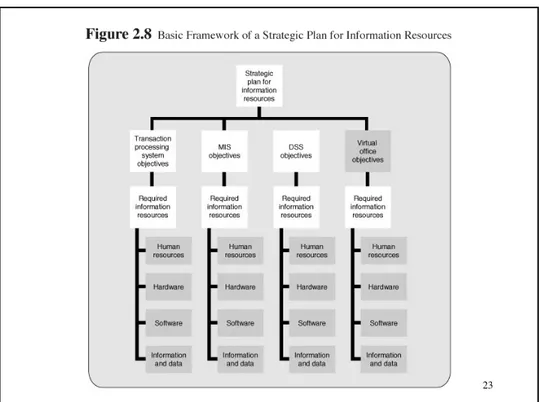1
CHAPTER 2
INFORMATION SYSTEMS
FOR COMPETITIVE
ADVANTAGE
Management Information Systems, 10thedition,
By Raymond McLeod, Jr. and George P. Schell © 2007, Prentice Hall, Inc.
Presented by
Prof. Dr. Deden Mulyana, SE., M.Si.
THE FIRM AND ITS ENVIRONMENT
• The physical system of a firm is an open system in that it interfaces with its environment
• Firms take resources from their environments, transforms these resources into products and services, and return the transformed resources to the environment
• Figure 2.1 shows this flow of resources from the environment, through the firm, and back to the environment
3
The General Systems Model of
the Firm
• Figure 2.1 shows three flows:
– The Physical Resource Flow: includes personnel, material, machines, and money
5
Environmental Resource Flows
• The firm is connected to its environmental elements through resource flows, including:
• information flowing from customers; • materials flowing to customers; • money flowing to stockholders; • machinery flowing from suppliers; • personnel flowing from suppliers; and • the global community and labor unions • Less frequent flows include: the money flow from
7
COMPETITIVE ADVANTAGE
• In the IS field, competitive advantagerefers to the use of information to gain marketplace leverage • Porter argues that firms achieve competitive
advantage by providing one of the following:
– products and services at a lower price, – higher quality products and services, or
– meeting the special needs of certain market segments
• An important point to recognize is that the firm’s managers use both conceptual and physical resources to meet the firm’s strategic objectives
Porter’s Value Chains
• Porter argued that firm’s opportunities to create competitive advantage occur at different steps in the value chain(Figure 2.3)
• The Marginis the value of the firm’s products and services less their costs, as perceived by the firm’s customers
• The value chain is made of the primary and support activities that contribute to a firm’s
margin value. Increasing that marginal value is the objective of the chain model
9
Expanding the Scope of the
Value Chain
(Figure 2.4)
• Additional advantages that can be achieved
by linking the firm’s value chain to those of
other organizations creating an
inter-organizational system (IOS)
• The participating firms (
business partners
)
work as a coordinated unit, creating a
synergy that cannot be achieved by working
alone
11
The Dimensions of Competitive
Advantage
1. Strategic advantage: plans used to achieve an advantage
2. Tactical advantage: methods for accomplishing a strategy in a better way than competitors do
3. Operational advantage: everyday transactions and processes that confer an advantage
13
The Dimensions of Competitive Advantage
(cont.)
• Competitive advantage can be created at all three levels of the corporate pyramid:
– Strategic advantage:
advantage achieved through the selection of the fundamental strategic direction and destination of the firm – Tactical advantage: methods
for accomplishing a strategy in a better way than competitors do
– Operational advantage: everyday transactions and processes that confer an advantage
CHALLENGES FROM GLOBAL
COMPETITORS
• The biggest players in today’s global
marketplace are multinational corporations
(MNCs)
• Information processing and
communications-based coordination are especially crucial for
an MNC due to the scale and geographic
dispersal of their business activities
• Coordination, in particular, has become a key
to achieving competitive advantage in a
15
INFORMATION MANAGEMENT
• A firm’s information resources consist of: – Computer hardware
– Computer software – Information specialists – Users
– Facilities – Databases – Information
• Achieving competitive advantage through the use of information requires the effective management of these resources, otherwise known as
information management
The Dimensions of Information
• Information can be viewed as having four basic dimensions that contribute to information value: • Relevancy:information is relevant when it
pertains to the problem at hand
• Accuracy: information has value when it is accurate
• Timeliness:Information should be available for problem solving before crisis situations develop or opportunities are lost
17
The Changing Nature of
Information Management
• The task of information management faces new problems as new technologies are making older style transaction processing systems obsolete • Managing “legacy systems” is one such problem,
such as converting them to run on new hardware • The use of multimedia data means that image
managementis now a second important task for information managers
• Knowledge management is a third task, requiring an easy-to-use database management system and software packages for use in analyzing data
STRATEGIC PLANNING FOR
INFORMATION RESOURCES
• The chief information officer (CIO)provides the strategic direction for a firm’s information
resources; and
• The CIO also coordinates the IS department’s strategic effort with the firm’s overall strategic business plan
19
Strategic Planning for Information
Resources (SPIR)
• SPIR is the concurrent development of strategic
plans for both the firm and its information services • Developing the two plans together means that the
firm’s plan will reflect the support provided by information services and the information services plan will reflects the future demands for systems support
21
Core Content of a Strategic
• Figure 2.8 shows the basic framework for a strategic plan for information resource management
• Two core topics that should be in every firm’s strategic plan for information resources are: 1. The objectives to be achieved by each
category of information system during the time period covered by the plan
23
An Example Strategic Plan for
Information Resources
Figure 2.9 (see text) is an example of an SPIR
report. It includes the following aspects:
• An executive summary, spelling out the goals
of the firm's information services unit;
• Definitions of the scope of IT services in
three organizational units; and
• A summary of the work plan for
25
GLOBAL BUSINESS STRATEGIES
•
Bartlett and Ghoshal identified 4 main
strategic ways that MNCs can use
information to coordinate the activities of a
parent company with its subsidiaries (see
Figs. 2.10-13):
1. Decentralized control strategy
2. Centralized control strategy
3. Centralized expertise strategy
4. Centralized control and distributed
29
